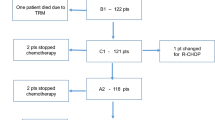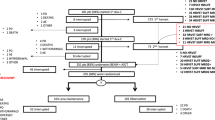Abstract
The efficacy of high-dose chemotherapy followed by autologous hematopoietic SCT for relapsed diffuse large B-cell lymphoma (DLBCL) has been reported, but an optimal conditioning regimen has not been determined. This study was conducted to evaluate the safety and efficacy of the MCVAC regimen (consisting of ranimustine (MCNU), cytarabine, etoposide and CY) followed by autologous peripheral blood stem cell transplantation (PBSCT) for patients with high-risk or relapsed DLBCL. A total of 40 patients with DLBCL who received the MCVAC regimen followed by autologous PBSCT were retrospectively evaluated. Median follow-up duration of the surviving patients was 51.2 months (range, 5.4–151.2 months). At 5-year OS and PFS were 73.7% (95% confidence interval (CI), 58.6–88.8) and 62.5% (95% CI, 46.8–78.2), respectively. Although relapse remained the most frequent cause of treatment failure, late-onset adverse events were observed, including two cases of severe pulmonary impairment, and two cases of therapy-related myelodysplastic syndromes (MDS)/AML. In conclusion, the MCVAC regimen would be an effective and tolerable conditioning regimen without TBI for autologous PBSCT for high-risk or relapsed DLBCL. However, late-onset pulmonary toxicity and MDS/AML should be monitored.
This is a preview of subscription content, access via your institution
Access options
Subscribe to this journal
Receive 12 print issues and online access
$259.00 per year
only $21.58 per issue
Buy this article
- Purchase on SpringerLink
- Instant access to full article PDF
Prices may be subject to local taxes which are calculated during checkout

Similar content being viewed by others
References
Sehn LH, Donaldson J, Chhanabhai M, Fitzgerald C, Gill K, Klasa R et al. Introduction of combined CHOP plus rituximab therapy dramatically improved outcome of diffuse large B-cell lymphoma in British Columbia. J Clin Oncol 2005; 23: 5027–5033.
Feugier P, Van Hoof A, Sebban C, Solal-Celigny P, Bouabdallah R, Ferme C et al. Long-term results of the R-CHOP study in the treatment of elderly patients with diffuse large B-cell lymphoma: a study by the Groupe d'Etude des Lymphomes de l'Adulte. J Clin Oncol 2005; 23: 4117–4126.
Pfreundschuh M, Trumper L, Osterborg A, Pettengell R, Trneny M, Imrie K et al. CHOP-like chemotherapy plus rituximab versus CHOP-like chemotherapy alone in young patients with good-prognosis diffuse large-B-cell lymphoma: a randomised controlled trial by the MabThera International Trial (MInT) Group. Lancet Oncol 2006; 7: 379–391.
Fisher RI, Gaynor ER, Dahlberg S, Oken MM, Grogan TM, Mize EM et al. Comparison of a standard regimen (CHOP) with three intensive chemotherapy regimens for advanced non-Hodgkin's lymphoma. N Engl J Med 1993; 328: 1002–1006.
Velasquez WS, Cabanillas F, Salvador P, McLaughlin P, Fridrik M, Tucker S et al. Effective salvage therapy for lymphoma with cisplatin in combination with high-dose Ara-C and dexamethasone (DHAP). Blood 1988; 71: 117–122.
Longo DL, Duffey PL, Young RC, Hubbard SM, Ihde DC, Glatstein E et al. Conventional-dose salvage combination chemotherapy in patients relapsing with Hodgkin's disease after combination chemotherapy: the low probability for cure. J Clin Oncol 1992; 10: 210–218.
Velasquez WS, McLaughlin P, Tucker S, Hagemeister FB, Swan F, Rodriguez MA et al. ESHAP—an effective chemotherapy regimen in refractory and relapsing lymphoma: a 4-year follow-up study. J Clin Oncol 1994; 12: 1169–1176.
Caballero MD, Amigo ML, Hernandez JM, Vazquez L, del Canizo C, Gonzalez M et al. Alternating mini-BEAM/ESHAP as salvage therapy for refractory non-Hodgkin's lymphomas. Ann Hematol 1997; 74: 79–82.
Gutierrez M, Chabner BA, Pearson D, Steinberg SM, Jaffe ES, Cheson BD et al. Role of a doxorubicin-containing regimen in relapsed and resistant lymphomas: an 8-year follow-up study of EPOCH. J Clin Oncol 2000; 18: 3633–3642.
Bosly A, Coiffier B, Gisselbrecht C, Tilly H, Auzanneau G, Andrien F et al. Bone marrow transplantation prolongs survival after relapse in aggressive-lymphoma patients treated with the LNH-84 regimen. J Clin Oncol 1992; 10: 1615–1623.
Salles G, Shipp MA, Coiffier B . Chemotherapy of non-Hodgkin's aggressive lymphomas. Semin Hematol 1994; 31: 46–69.
Philip T, Guglielmi C, Hagenbeek A, Somers R, Van der Lelie H, Bron D et al. Autologous bone marrow transplantation as compared with salvage chemotherapy in relapses of chemotherapy-sensitive non-Hodgkin's lymphoma. N Engl J Med 1995; 333: 1540–1545.
Rodriguez MA, Cabanillas FC, Velasquez W, Hagemeister FB, McLaughlin P, Swan F et al. Results of a salvage treatment program for relapsing lymphoma: MINE consolidated with ESHAP. J Clin Oncol 1995; 13: 1734–1741.
Shipp MA, Abeloff MD, Antman KH, Carroll G, Hagenbeek A, Loeffler M et al. International Consensus Conference on high-dose therapy with hematopoietic stem cell transplantation in aggressive non-hodgkin's lymphomas: report of the jury. J Clin Oncol 1999; 17: 423–429.
Meehan KR, Pritchard RS, Leichter JW, Littenberg B, Welch HG . Autologous bone marrow transplantation versus chemotherapy in relapsed/refractory non-Hodgkin's lymphoma: estimates of long-term survival from the recent literature. Am J Hematol 1995; 50: 116–123.
Salar A, Sierra J, Gandarillas M, Caballero MD, Marin J, Lahuerta JJ et al. Autologous stem cell transplantation for clinically aggressive non-Hodgkin's lymphoma: the role of preparative regimens. Bone Marrow Transplant 2001; 27: 405–412.
Takaue Y, Watanabe T, Hoshi Y, Abe T, Matsunaga K, Saito S et al. Effectiveness of high-dose MCNU therapy and hematopoietic stem cell autografts treatment of childhood acute leukemia/lymphoma with high-risk features. Cancer 1991; 67: 1830–1837.
The International Non-Hodgkin's Lymphoma Prognostic Factors Project. A predictive model for aggressive non-Hodgkin's lymphoma. N Engl J Med 1993; 329: 987–994.
Caballero MD, Perez-Simon JA, Iriondo A, Lahuerta JJ, Sierra J, Marin J et al. High-dose therapy in diffuse large cell lymphoma: results and prognostic factors in 452 patients from the GEL-TAMO Spanish Cooperative Group. Ann Oncol 2003; 14: 140–151.
Martin A, Caballero MD, Perez-Simon JA, Lopez-Holgado N, Mateos MV, Canizo MC et al. Results of autologous transplantation in lymphoma are not improved by increasing the dose of etoposide in the BEAM regimen: a single-centre sequential-cohort study. Bone Marrow Transplant 2004; 34: 675–682.
Jo JC, Kang BW, Jang G, Sym SJ, Lee SS, Koo JE et al. BEAC or BEAM high-dose chemotherapy followed by autologous stem cell transplantation in non-Hodgkin's lymphoma patients: comparative analysis of efficacy and toxicity. Ann Hematol 2008; 87: 43–48.
Metayer C, Curtis RE, Vose J, Sobocinski KA, Horowitz MM, Bhatia S et al. Myelodysplastic syndrome and acute myeloid leukemia after autotransplantation for lymphoma: a multicenter case-control study. Blood 2003; 101: 2015–2023.
Howe R, Micallef IN, Inwards DJ, Ansell SM, Dewald GW, Dispenzieri A et al. Secondary myelodysplastic syndrome and acute myelogenous leukemia are significant complications following autologous stem cell transplantation for lymphoma. Bone Marrow Transplant 2003; 32: 317–324.
Patti C, Majolino I, Scime R, Indovina A, Vasta S, Liberti G et al. High-dose cyclophosphamide, etoposide and BCNU (CVB) with autologous stem cell rescue in malignant lymphomas. Eur J Haematol 1993; 51: 18–24.
Mills W, Chopra R, McMillan A, Pearce R, Linch DC, Goldstone AH . BEAM chemotherapy and autologous bone marrow transplantation for patients with relapsed or refractory non-Hodgkin's lymphoma. J Clin Oncol 1995; 13: 588–595.
Stiff PJ, Dahlberg S, Forman SJ, McCall AR, Horning SJ, Nademanee AP et al. Autologous bone marrow transplantation for patients with relapsed or refractory diffuse aggressive non-Hodgkin's lymphoma: value of augmented preparative regimens—a Southwest Oncology Group trial. J Clin Oncol 1998; 16: 48–55.
Alessandrino EP, Bernasconi P, Colombo A, Caldera D, Martinelli G, Vitulo P et al. Pulmonary toxicity following carmustine-based preparative regimens and autologous peripheral blood progenitor cell transplantation in hematological malignancies. Bone Marrow Transplant 2000; 25: 309–313.
Author information
Authors and Affiliations
Corresponding author
Ethics declarations
Competing interests
The authors decalre no conflict of interest.
Rights and permissions
About this article
Cite this article
Kato, J., Mori, T., Yokoyama, K. et al. Safety and efficacy of high-dose ranimustine, cytarabine, etoposide and CY (MCVAC) regimen followed by autologous peripheral blood stem cell transplantation for high-risk diffuse large B-cell lymphoma. Bone Marrow Transplant 46, 923–928 (2011). https://doi.org/10.1038/bmt.2010.243
Received:
Revised:
Accepted:
Published:
Issue date:
DOI: https://doi.org/10.1038/bmt.2010.243
Keywords
This article is cited by
-
RETRACTED ARTICLE: High-dose therapy and autologous stem cell transplantation for relapsed or high-risk diffuse large B-cell lymphoma: a nationwide survey
International Journal of Hematology (2020)
-
Safety and efficacy of high-dose ranimustine (MCNU) containing regimen followed by autologous stem cell transplantation for diffuse large B-cell lymphoma
International Journal of Hematology (2018)
-
Retrospective evaluation of the MEAM regimen as a conditioning regimen before autologous peripheral blood stem cell transplantation for lymphoma in two centers with different dosing schedules of melphalan
Annals of Hematology (2016)
-
Angioimmunoblastic T-cell lymphoma with intramedullary production of platelet-derived growth factor and possibly complicating myelofibrosis: report of a case with review of the literature
International Journal of Hematology (2013)
-
Safety and feasibility of high-dose ranimustine (MCNU), carboplatin, etoposide, and cyclophosphamide (MCVC) therapy followed by autologous stem cell transplantation for malignant lymphoma
International Journal of Hematology (2012)



